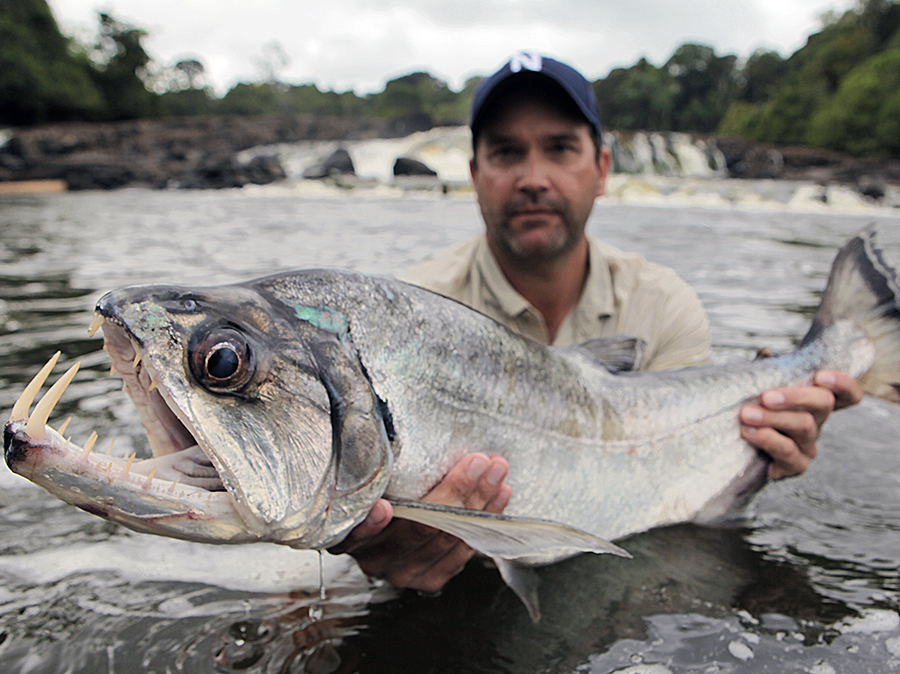It was in Thailand 25 years ago that biologist Zeb Hogan saw his first giant freshwater fish.
“I was on an exchange program in Thailand and on a visit to the Mekong River I saw a group of fishermen catch a Mekong giant catfish – they had pulled the fish into a small boat and the fish was almost as big as the boat,” Hogan said. “I'd guess that particular catfish weighed about 400 pounds and measured 8 feet in length. It made an impression; I'd never seen such a large freshwater fish.”
That experience set Hogan on his quest to find, study and protect freshwater megafish – fish longer than 6 feet and heavier than 200 pounds – and to bring awareness to their precarious fight to stave off extinction. He’s been on every continent on Earth except Antarctica.
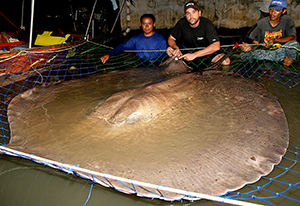
“I never stopped or wanted to stop traveling, meeting new people and learning about places that are relevant to my work,” he said. “As a research biologist, I spend most of my travel time working with scientists and fishermen on large lakes and rivers. That work has taken me to the Amazon, the Nile, the Mekong, and the Yangtze; to remote areas in Mongolia, Australia, Argentina and Alaska. Each of those trips will always be important to me in its own way.”
Hogan may be best known for his long-running NatGeoWild television show Monster Fish, in which he shares his story of traveling the globe for his research on the world’s largest freshwater fish. But his work is much more extensive. He focuses on freshwater biodiversity. His work reaches to protecting the ecosystems where the fish live, and the communities that depend on them.
For his international work, the University’s Ozmen Institute for Global Studies has given the 2020 Global Engagement Award to Hogan.
“Zeb is an outstanding scientific ambassador for UNR, and he epitomizes the globally engaged faculty member,” Jack Hayes, chair of the Department of Biology in the College of Science, said. “Receiving the award just makes sense.”
College of Science Dean Jeff Thompson has spent some time with Hogan on one of his trips to Mongolia to study the world’s largest freshwater trout, the Taiman, which can grow to six feet.
“Zeb views his research on giant freshwater species in terms of the local people, cultures and locations,” Thompson said. “He is immersed in the daily lives of scientists and people in the countries where he works and his research is purposed within the context of these people and cultures. He is an excellent scientist and scholar, but if you spend time with Zeb you quickly learn to appreciate his ability to view the impact and scope of his research through the lens of the people who live and interact with the fish and environments he studies.”
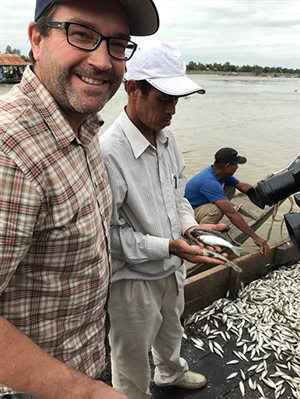
Hogan’s penchant for travel and his concern for the environment are finely melded. As a high school kid in Arizona, he dreamed of travelling; and he participated in exchange programs whenever he could.
“I've always been curious about other places and my parents encouraged that curiosity,” he said. “My family hosted exchange students growing up and I participated in exchanges through my high school and our local Sister Cities program. As I got older, I sought out opportunities to study and travel abroad.”
As an undergraduate at the University of Arizona, he applied for scholarships for international work and was able to spend time studying in France, Mexico, Botswana and Madagascar. It took him five years to graduate. A standout experience for him was traveling to Asia for the first time when he was 23 years old. He couldn’t wait to get back.
“After I received my undergraduate degree I lived for a year in Thailand, then continued working in the Mekong region for my Ph.D.,” he said.
Hogan has been working internationally since receiving his Fulbright Scholarship in 1997. While a doctoral student at the University of California Davis, he received two small grants: one from the Wildlife Conservation Society and one from National Geographic.
“Those grants – that initial small amount of support and encouragement – grew into what is now an international research and outreach program that has reached millions of children, students, and young professionals all over the world,” he said. “Seeing the initial support of Fulbright and National Geographic grow into a global research and outreach program that has reached millions is a highlight for me. I'm proud of the university and our community for continuing to support students and faculty to engage in international research and outreach.”
Hogan has been on faculty as a research assistant professor since 2006, is now a member of the Aquatic Ecosystems Analysis Laboratory in the Biology Department and a member of the University’s Global Water Center.
“While my research focuses on freshwater biodiversity, I think many of my finest memories and proudest moments connect to the people that I meet through my work,” he said. “For the last 20 years, I’ve worked with the same fishermen in Cambodia and I've had a chance to see their children grow up to be conservation-minded adults. I was one of twenty international students in an exchange program at Chiang Mai University in Thailand. Now, two decades later, those students are colleagues and leaders in their own countries and their own fields.”
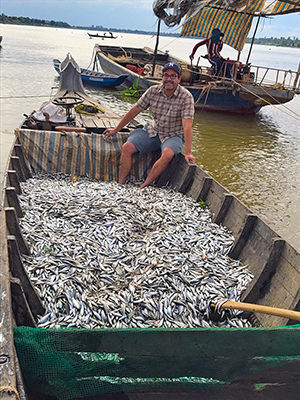
His current signature project, of which he is the Principal Investigator, is the $9.6 million USAID project the Wonders of the Mekong in Cambodia. It seeks to identify a sustainable future for the food security and economic dependence, by melding a scientific understanding with historical knowledge of the Mekong river system and the people who use it. The Mekong is critical to the food and livelihoods of more than 60 million people. Only the Amazon supports a higher level of fish biodiversity.
The project engages local communities, scientists and managers who are integrally involved; and there is a major outreach and educational component to the work.
“The Wonders of the Mekong: A Foundation for Sustainable Development and Resilience” studies the biodiversity, climate and hydrology of the Mekong River Basin, build partnerships between organizations working toward a sustainable future for the region, and develop educational materials to increase awareness about the value of a healthy Mekong River.
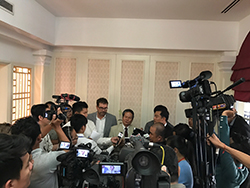
“Through our multi-pronged research we will better understand and document the many values of the internationally significant assets of the Mekong,” Hogan said. “We’ll communicate our findings to the region and the world as we create a new model of effective stewardship for the river and lake systems to help protect the heavily impacted vulnerable communities, all of which depend on the river for billions of dollars of ecosystem services.”
His work has led to adoption of many local and regional fish and river conservation measures around the world. He also has established, and works to establish, conservation programs in the areas he studies to help protect the fish. For example, partly as a result of Hogan’s work with the governments of Cambodia, Thailand, and Laos, capture of the Mekong giant catfish is now protected in those countries. He’s also helped communities in the United States create conservation programs to help protect fish habitat.
His work encompasses 10 of Earth's most diverse freshwater ecosystems – ecological treasures – including World Heritage Sites, Ramsar Wetlands of International Importance and United Nations Environment Program Biodiversity Hotspots.
Participating in more than 30 NatGeoWild documentaries around the world with the opportunities to study and share stories of the world's largest freshwater fish is one of the highlights of his work. His Monster Fish programs have reached an estimated 440 million households in 171 countries in 38 languages.
Hogan has traveled to remote villages and jungles around the world, boating up the headwaters of the Amazon or diving in the frigid waters of Mongolian rivers and lakes. His television programs show him standing in chest-deep water beside a 14-foot stingray, swimming with a 400-pound “man-eating” Goonch in the Himalayas or with a 700-volt eel in the Amazon River; including on the "River of Doubt" a tributary to the Amazon in Brazil – which was explored by Theodore Roosevelt in the early 1900s and has been largely ignored since then.
Monster fish represent only one quarter of one percent of all species of freshwater fish. A few of these fish live longer than humans, attaining ages of 90, 100 or even 150 years of age. Evolutionarily speaking, giant fish families like sturgeon, stingrays and gar pre-date dinosaurs, existing in much the same form for 200 million years.
“These fish are bellwethers for the health of the rivers, and the ecosystems, and we’ve found the populations are declining,” he said. “As I am the United Nations Convention on Migratory Species Councilor for Fish, I see the global decline in fish populations by the numbers, and help guide the organization as they declare a species threatened or endangered as a way to guide nations around the world to take measures to protect migratory fish populations.”
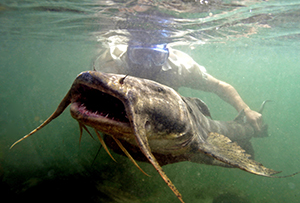
From 2011 to 2017, Hogan was one of a handful of about 20 National Geographic Fellows in the world. Through that program he has mentored early career scientists in various countries around the world including Cambodia, Ecuador, the Philipines, Vietnam and the United States. He is also a National Geographic Explorer. a member of the Freshwater Fish Specialist Group for the International Union for Conservation of Nature and one of the organizers of World Fish Migration Day since its inception in 2015.
Through the support of the College of Science and National Geographic, Hogan’s research is featured in a traveling museum exhibit. Since 2016, the world has been learning about the two dozen rare fish species through National Geographic’s Monster Fish exhibition. The traveling 6,000 square-foot museum exhibition successfully debuted in Washington D.C. for six months and after made its first stop in Reno before making its way around the country and even one international exhibition.
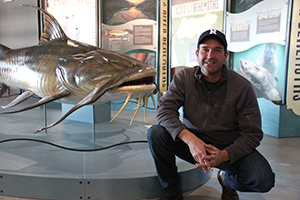
“The exhibition's messages - that there are amazing creatures in our rivers and lakes waiting to be discovered, that freshwater is a valuable and scarce resource, that aquatic life needs our help and appreciation to survive, are important messages for everyone especially those of us living in arid regions like Nevada,” he said.
“The Last River Giants” exhibition features stunning life-size sculptures, hands-on interactive exhibits and evocative video installations that put the exhibit-goer face-to-face with the behemoth freshwater fish. Not quite as face-to-face as Hogan gets, but perhaps the next best thing short of traveling the globe.
While always thinking of his home, Nevada, his global perspective is important to him.
“How can we make sense of the world without a global perspective?” he said. “Everywhere I've been, I've encountered friendly people, who or more or less just like me, who want the same basic things, and as a team we work together for a common goal. I recognize that not every interaction between two people, or two nations, can be positive, but a global perspective enables us to see how and why we should work together, not at odds with one another.
“I’m pleased, seeing the growing appreciation of the importance of global research and engagement at UNR, led by the College of Science.”
Accustomed to travel much of the year, the pandemic restrictions on travel has affected how he connects with his collaborators around the world. Instead of planes, trucks, boats, horseback and hiking to meet his colleagues, he has been confined to Reno, dealing with the precautions for the SARS-CoV-2 virus along with the rest of us, trying to get global work done from one spot.
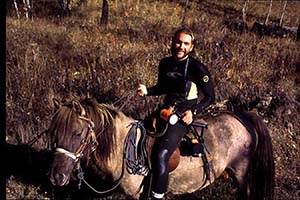
“As long as I am able to get up early or stay up late a few nights a week, it's not too bad,” he said. “Almost everyone I work with is available to talk for at least an hour sometime between 5 a.m. and 10 p.m. PST. We call, email, text, Facetime, WhatApp, Zoom, Google Hangout, and Skype.”
The Global Engagement Award is a university wide award of the Ozmen Institute for Global Studies for full-time academic faculty and administrative faculty in recognition of their outstanding contributions to international programs, international program development, academic and global research programs, or international research and outreach at the University of Nevada, Reno.
“I appreciate the award; it acknowledges the importance of global engagement and, each year, highlights the work of people at the university conducting research, scholarship, and community outreach for a better understanding of our world and its challenges. I would like to acknowledge the support of the university, especially the College of Science, and the students and faculty affiliated with the Global Water Center and the Department of Biology.”
